Salesforce data-in integration
PremiumThis feature is available for Premium plans. EnterpriseThis feature is available for Enterprise plans. UpdatedThe Salesforce source lets you send data from your CRM to destinations where you can activate it. For example, you can send Salesforce data to Customer.io where you can automatically message people—follow up with leads, message contacts when it’s time to renew their contracts, and so on. This makes Salesforce a part of your larger marketing stack without needing developers to write a complicated integration.
Quick start video
Here’s a quick overview of the setup process for our incoming Salesforce integration. In this video, we set up Salesforce to send Contacts and Accounts to Customer.io.
Before you begin
Before you begin, you should ask yourself how you want to use your Salesforce data. The data that you send to Customer.io—as People, Events, Custom Objects, or Relationships between people and objects—may depend on what you want to do with your data in Customer.io and what downstream services you want to send it to. See Working with Salesforce Data for help mapping data.
Working with Salesforce data
Unlike Customer.io and other platforms, Salesforce doesn’t have generic concepts like People and Groups—or things that map easily to those terms. Instead, Salesforce has highly structured data: your leads, contacts, opportunities, accounts, and other things are all separate.
When you send Salesforce data to Customer.io, you’ll have to determine whether each type of data represents People, Events, Custom ObjectsAn object is a non-person entity that you can associate with one or more people—like a company, account, or online course., or Relationships between people and objects. In most cases, this should be easy: contacts are people, because you’ll send them messages; an account is something many people are connected to, so it’s probably a custom object.
On this page, we recommend that you start with Contacts because they map to people. For other types of data, see Using Salesforce with Customer.io Journeys to learn more about using data with Customer.io specifically, or Mapping Salesforce data to destinations to learn more about mapping Salesforce data to other destinations.
with >1 person?} c--->|yes|d(Custom
Object) c-.->|no|e{Does it have an
email or phone?} e-->|yes|b e-.->|maybe/no|h{Does it relate a
person to a group?} h-.->|no|f{Is it something people do?
Will it trigger messages?} h--->|yes|i(Relationship) f-->|yes|g(Event) f-.->|no|d
Prerequisites
To connect Salesforce to Customer.io, you need:
- A Salesforce Data Cloud (sometimes called Sales Cloud) account that is either:
- At the Professional, Enterprise, level or higher.
- Includes Web Services API access.
- A Salesforce user with access to the data you want to send from Salesforce to Customer.io. In general, we suggest that you set up a user specifically for your syncs, making it easy to limit the data Customer.io can access and control your integration independently of your day-to-day Salesforce users.
Set up your Salesforce integration
When you set up your integration, you’ll configure your first Sync—the type of data that you want send to Customer.io and other destinationsAn integration that sends data out of Customer.io—your data’s ultimate destination.. We suggest that you start with Contacts because it’s the easiest, and most natural thing to send into Customer.io and other services.
You’ll set up subsequent syncs after you finish configuring your integration, where each sync brings in a different kind of data (leads, opportunities, and so on).
Go to Data & Integrations > Integrations. In the Directory tab, pick the Data In Salesforce integration
Set up your Salesforce connection:
- Give the integration a friendly Name so you’ll recognize it in Customer.io.
- Set up your sync. See Scheduled syncs for more information.
- If you’re logging in with your Salesforce Sandbox account, you’ll need to enable the Sandbox setting to test your integration.
Click Connect Salesforce and log into Salesforce. While you can login with any Salesforce user, you might want to login with an integration user—an account made specifically for this integration that helps you manage and limit the data available to Customer.io.
When you’ve logged into Salesforce, click Create Sync.
Create your first sync. This is a type of data that you send through your pipeline.
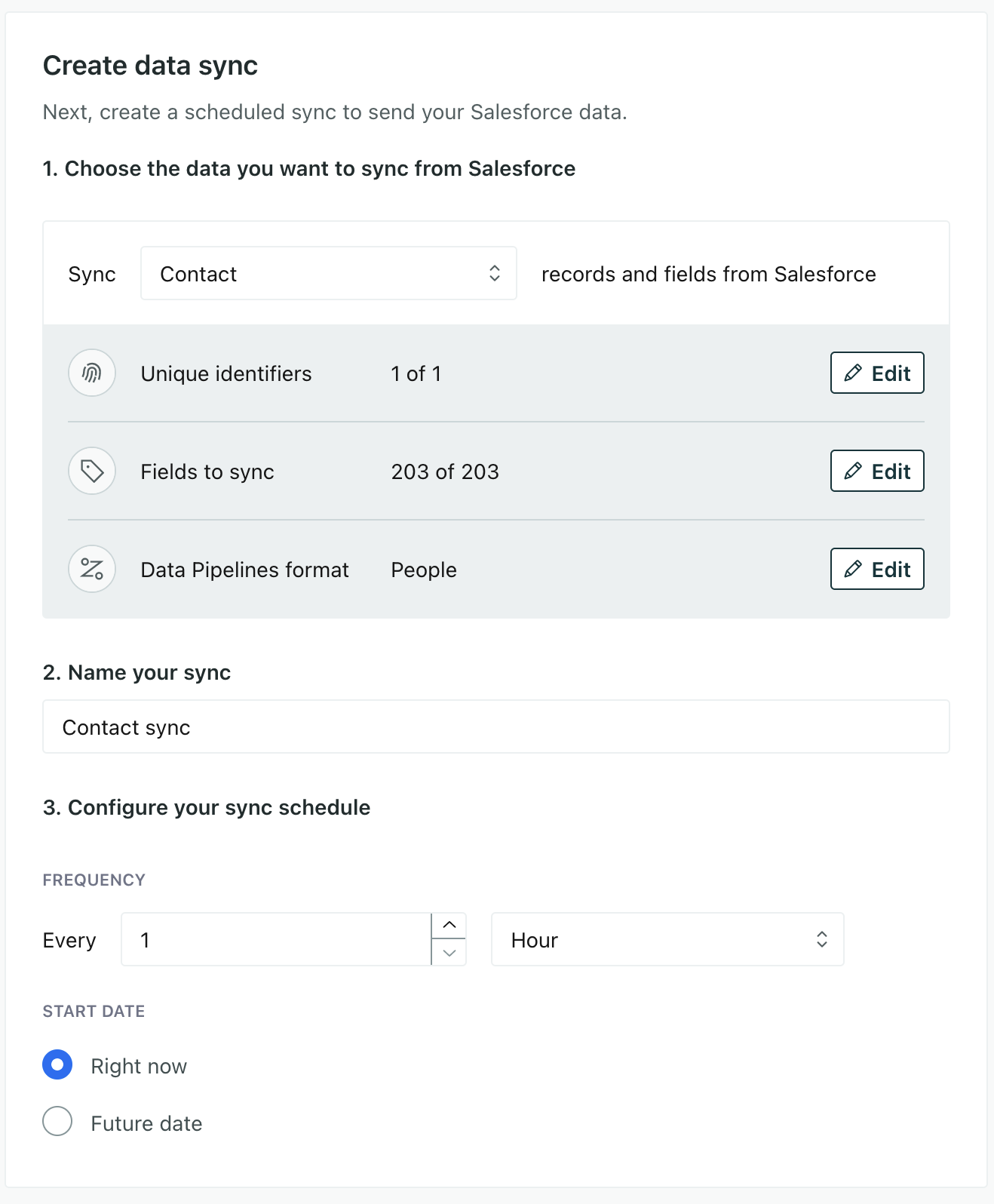

Give your sync a Name—something that describes the data you’re importing and what you’re mapping it to.
In the Sync dropdown, pick the kind of Salesforce record you want to send to Customer.io. Again, we suggest starting with Contacts.
Click Edit next to Unique identifiers map your identifier—the field that uniquely identifies each person or object. If you’re using Contacts, pick the Contact ID as your Contact ID.
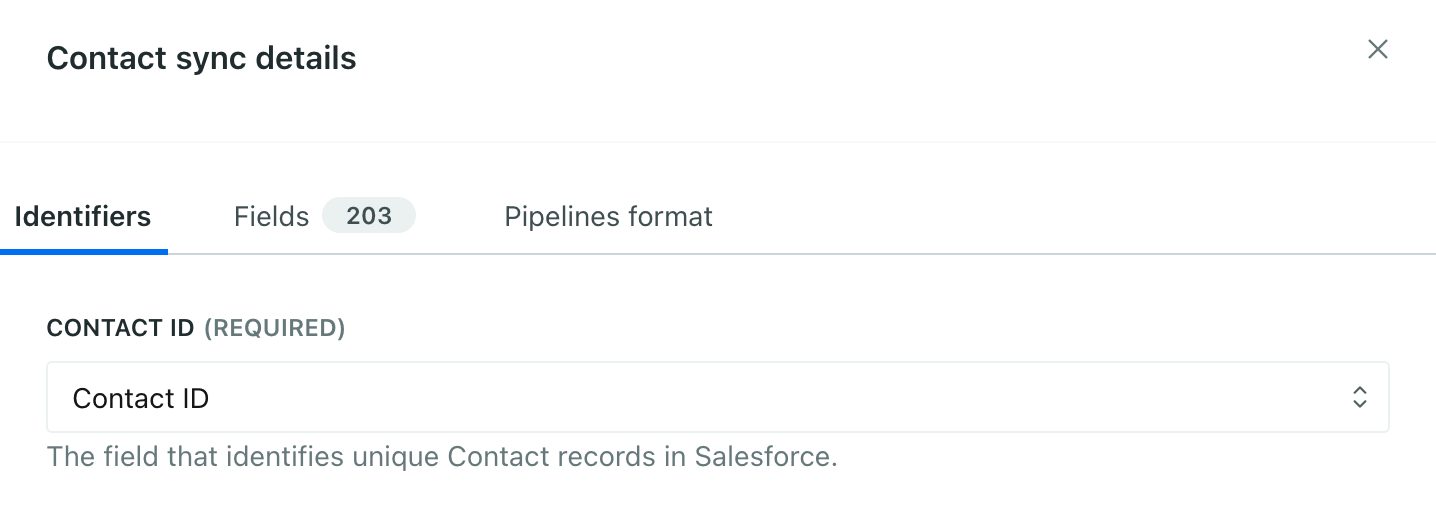

Go to the Fields tab and pick the fields you want to capture in Customer.io. Salesforce contains a lot of data, not all of which is useful in Customer.io. For example, you don’t need the mailing latitude or longitude to send email.
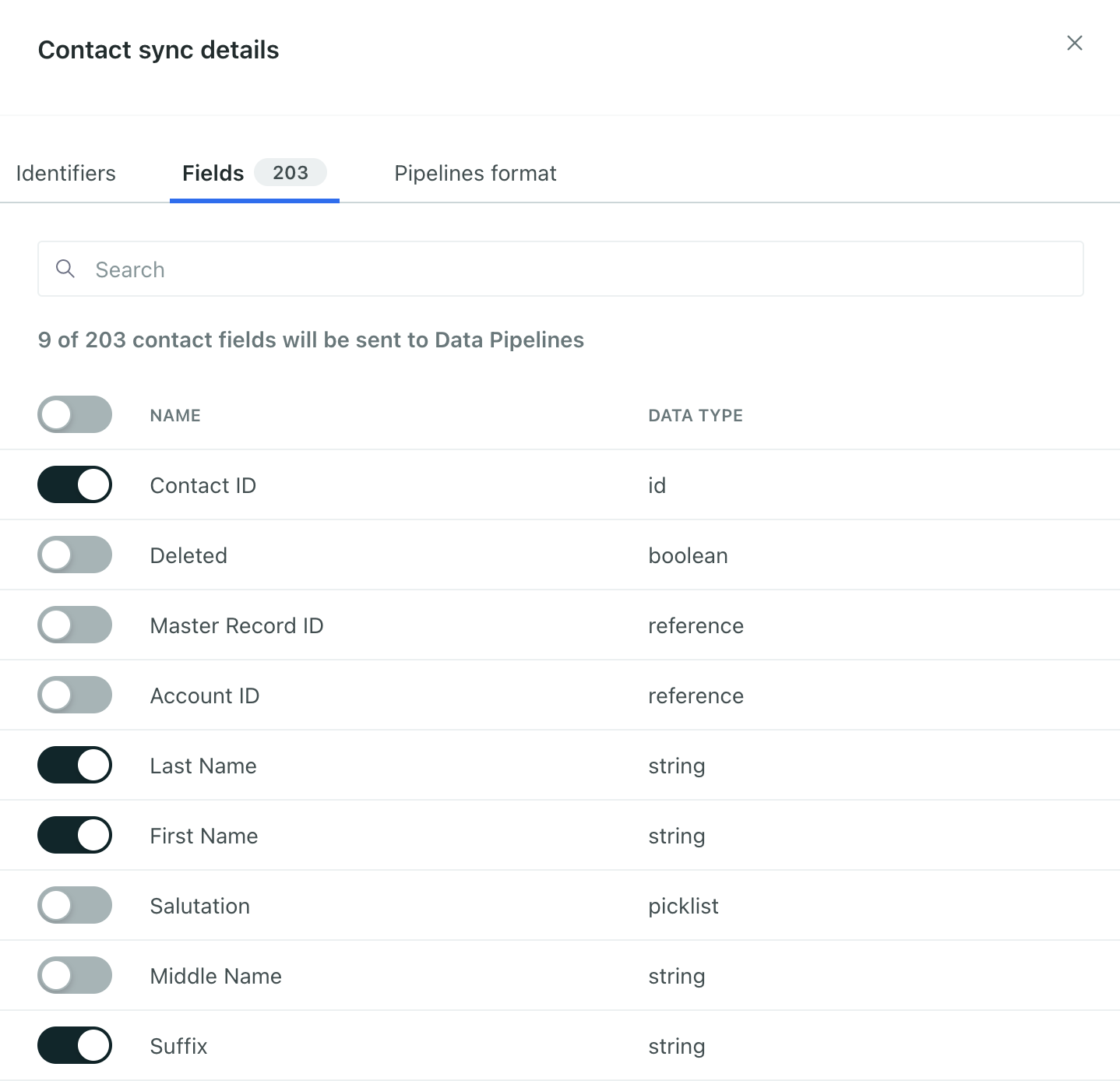

Click Add optional data filters if you want to bring a subset of your data into Customer.io. See Filter incoming data for more information.
If your sync isn’t Contacts, check the Pipelines format. For popular Salesforce data types, we’ll set these fields for you. For example, if you’re sending Accounts, Data Pipelines Format is automatically set to Custom Object and the Custom Object Name is set to Accounts.
Otherwise, these fields tell Customer.io how to interpret the data you send—whether your Salesforce data represents people, custom objectsAn object is a non-person entity that you can associate with one or more people—like a company, account, or online course., or relationshipsThe connection between an object and a person in your workspace. For instance, if you have Account objects, people could have relationships to an Account if they’re admins.. The Custom Object Name is an attribute we store so you’ll know which Salesforce data type your Customer.io data originated from.
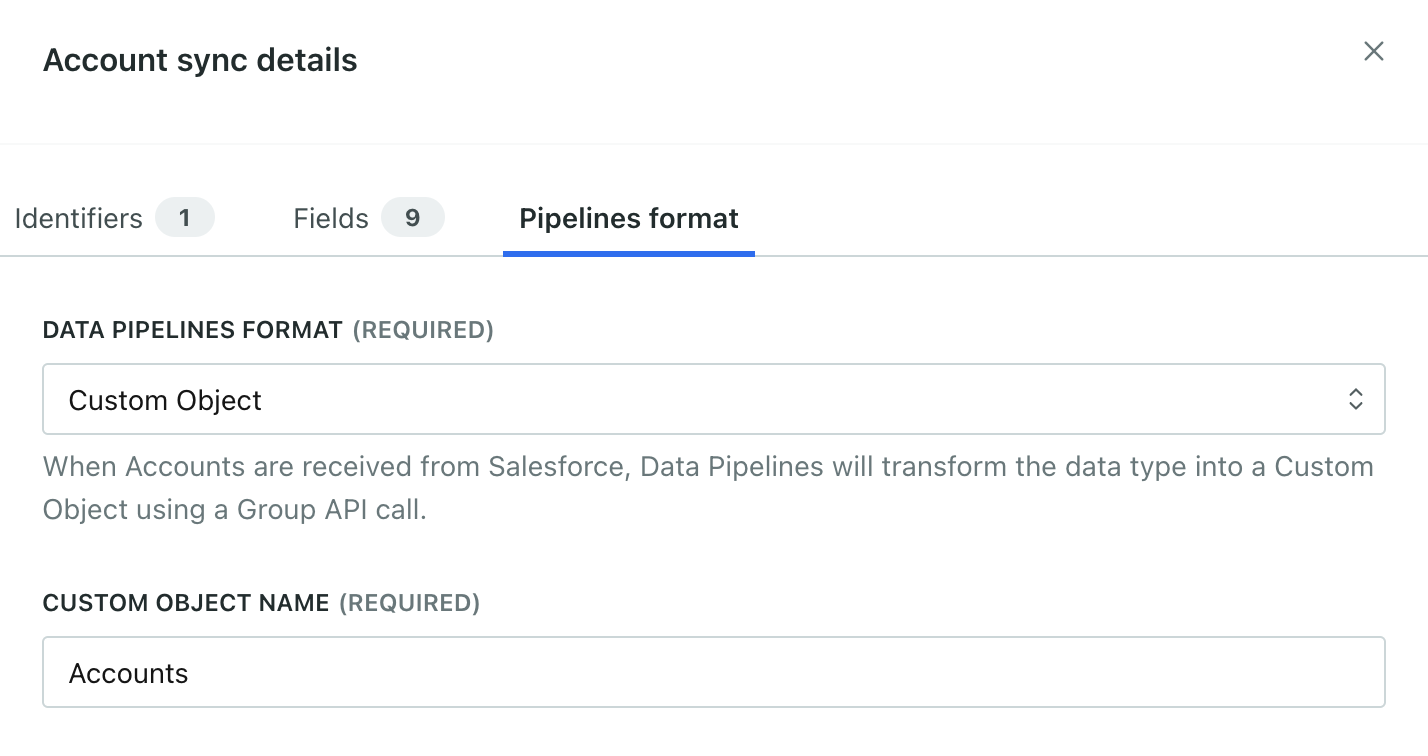

Choose how often you want to sync data and when you want to start.
Click Next: choose destinations and select places you want to connect your Salesforce data to. The destinations you connect to might depend on how you model your data! See Mapping data to destinations for more information.


If your Data Pipelines format is set to Custom Object or Relationship, you need to map them to a custom objectAn object is a non-person entity that you can associate with one or more people—like a company, account, or online course. in Customer.io. In most cases, this is the same name as the Salesforce object you want to sync (or relate people to). If you’re mapping something like Accounts to Customer.io, and Accounts don’t already exist, click New Object Type and set the singular and plural forms—like Account and Accounts.
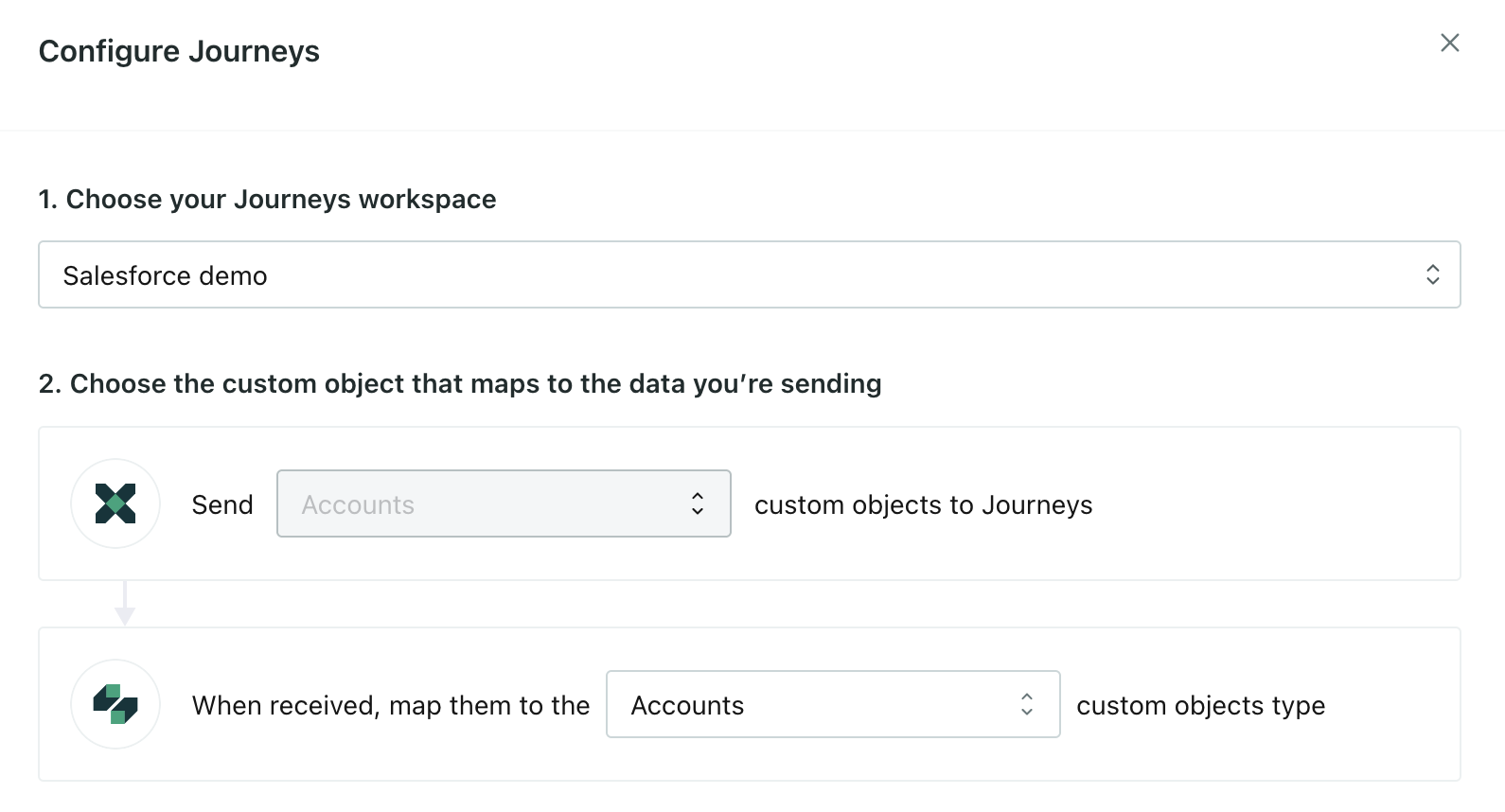

Click Enable Salesforce.
You’re successfully set up your first sync! You’ve created a sync for one type of Salesforce data, but you may also want to create syncs for other kinds of data you want to import from Salesforce.
The Syncs tab will show the status of your sync and note that we’re processing your Salesforce data. If you go into , you should begin seeing your Salesforce data—though it may take a few minutes to populate all your people, especially if you have millions of records.
Set up additional syncs
During the initial setup you’ll create a single sync when you set up your Salesforce integration. After that, you can set up additional syncs to import other kinds of data from Salesforce. To learn more about whether your data types are people, objects, or events, see Mapping Salesforce data to destinations.
Go to your Salesforce integration’s Syncs tab and click Add Sync.
Give your sync a Name—something that describes the data you’re importing and what you’re mapping it to.
Pick the kind of Salesforce record you want to send to Customer.io. If you’ve already synced contacts, you might want to sync the Accounts they’re connected to.
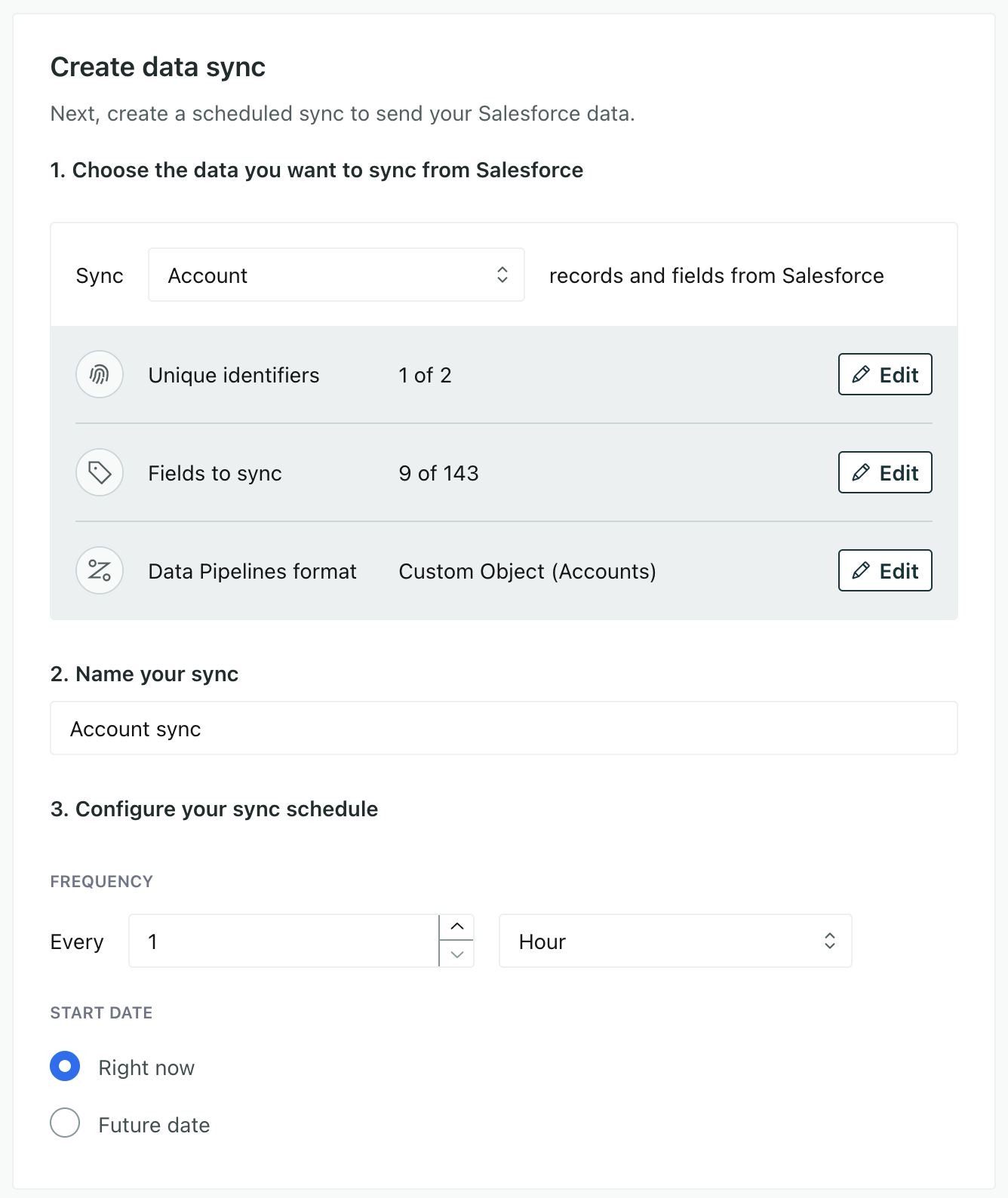

Click Edit next to Unique identifiers map your identifier—the field that uniquely identifies each person or object. For Accounts, this is usually the Account ID.
Go to the Fields tab and select the fields you want to capture for that data type and then click Save Changes.
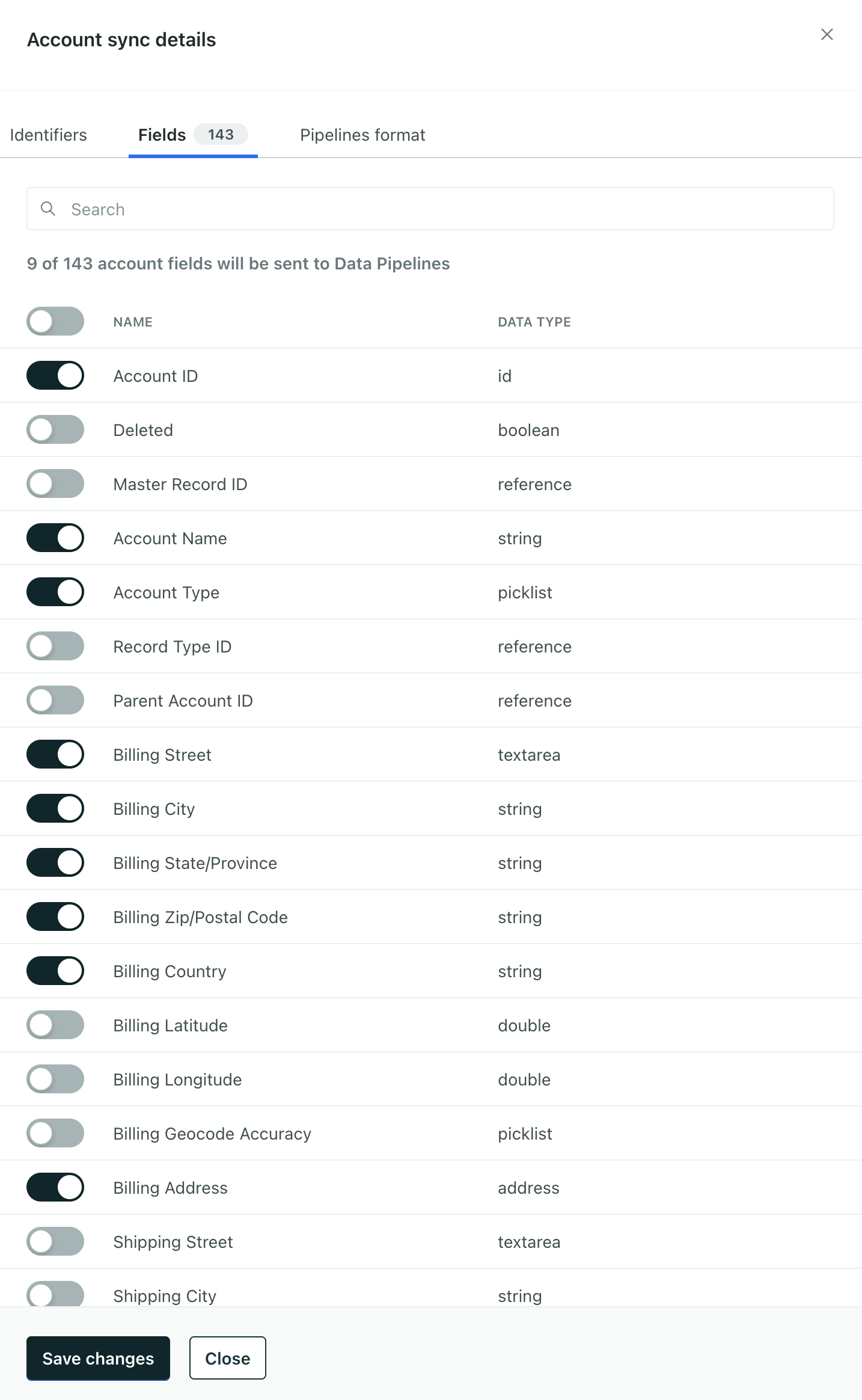

If your sync isn’t Contacts, check the Data Pipelines format. For popular Salesforce data types, we’ll set these fields for you. For example, if you’re sending Accounts, Data Pipelines Format is automatically set to Custom Object and the Custom Object Name is set to Accounts. For more information about the data pipelines format, see Mapping Salesforce data to Customer.io.
Otherwise, these fields tell Customer.io how to interpret the data you send—whether your Salesforce data represents people, custom objectsAn object is a non-person entity that you can associate with one or more people—like a company, account, or online course., or relationships. The Custom Object Name is an attribute we store so that you’ll know which Salesforce data type your Customer.io data originated from.


Click Add optional data filters to add filters to the data you want to bring into Customer.io. See Filter incoming data for more information. If you don’t add any filters, we’ll bring all data of the selected type from Salesforce.
Choose how often you want to sync data, when you want to start, and then click Configure Destinations.
If your Data Pipelines format is set to Custom Object or Relationship, you need to map them to a custom objectAn object is a non-person entity that you can associate with one or more people—like a company, account, or online course. in Customer.io. In most cases, this is the same name as the Salesforce object you want to sync (or relate people to). If you’re mapping something like Accounts to Customer.io, and Accounts don’t already exist, click New Object Type and set the singular and plural forms—like Account and Accounts.


Click Enable Sync
When you finish setting up your sync, the Syncs tab will show the status of your new sync and note that we’re processing your Salesforce data. If you go into the Journeys tab , you should begin seeing your Salesforce data—though it may take a few minutes to populate all your people, especially if you have millions of records
Filter incoming data
When you set up a sync, we bring all data of the selected type from Salesforce by default. For example, if you sync your Salesforce contacts, we’ll bring all your contacts into Customer.io. But you might not want all of your contacts—maybe you qualify your contacts or you only want to bring in contacts who meet certain thresholds.
That’s what the Add optional data filters button does: it lets you provide criteria for data you want to bring into Customer.io.
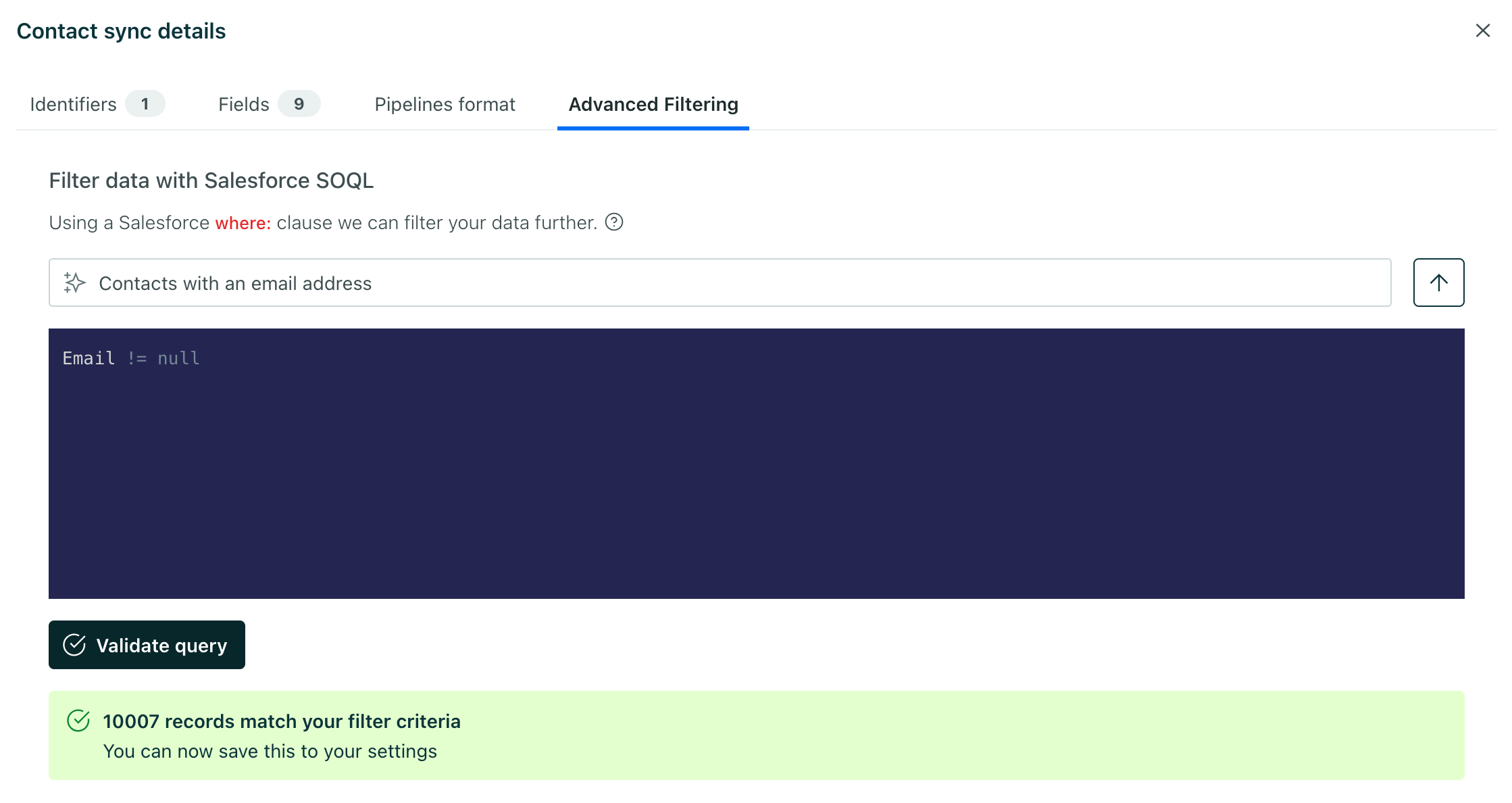

If you’re not comfortable writing your own query, you can use AI to generate a filter for you! Provide a plain-text description of the data you want to capture or exclude, and we’ll try to generate a filter for you.
If you write your own query, note that you don’t have to write the SELECT, FROM, or WHERE clauses. The filter acts as criteria for the WHERE clause of a Salesforce SOQL query, and the other sync settings cover the SELECT and FROM clauses. For example, if you only want to bring contacts into Customer.io if they have an email address, you could write a filter like this:
Email != null
Salesforce capitalizes field names
When you write your filter, remember that Salesforce uses pascal case field names (like FirstName). While you can change field names when you bring them into Customer.io, you’ll use the original field name from Salesforce for your filter.
What data is captured in each sync?
Your first sync captures all your current Salesforce data of the specified type. Subsequent syncs capture records that changed since the previous sync. This means that your first sync may take longer than subsequent syncs, as we gather all your Salesforce data with the initial sync.
For example, if you sync contacts, your first sync will send all of the current contacts in your Salesforce environment. The next sync will gather all changes to contacts—all your new contacts, updates, and deleted contacts—since the first sync.
We handle deletions differently from create and update operations!
When you delete records in Salesforce, we send events to record the deleted items. Customer.io handles these events automatically. But you may need to set up actionsThe source event and data that triggers an API call to your destination. For example, an incoming identify event from your sources adds or updates a person in our Customer.io Journeys destination. to delete data!
Updating syncs
When you update a sync to add or remove fields, your updates take affect at the next sync interval. This means that your changes don’t affect data that you’ve already sent from Salesforce (or any syncs in progress).
To update all data you’ve passed from Salesforce to Customer.io (and other places you send your Salesforce data to), you can Resync all data. This sends all of your corresponding Salesforce data through Customer.io again, updating all of your records with the changes you made to your sync.
On the Syncs tab, click next to the sync you updated and click Resync all data.
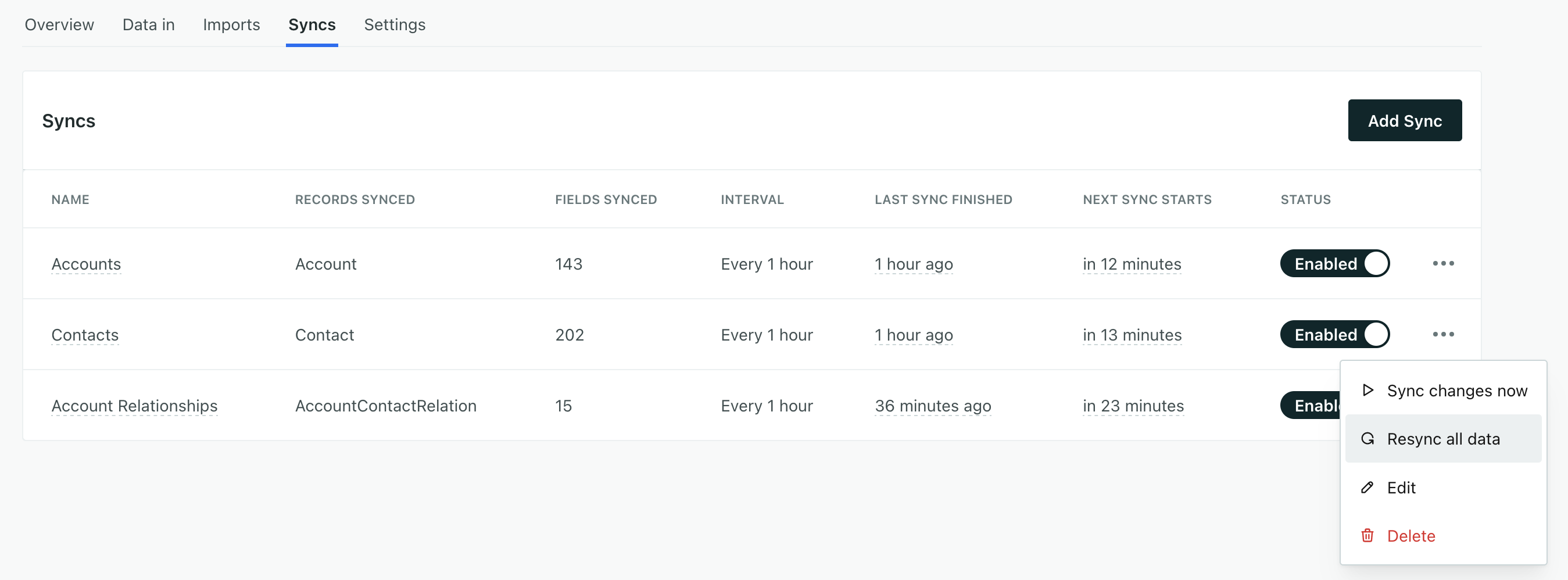

Manage access to Salesforce data with an “Integration User”
When you connect to Salesforce, you don’t need to use your own credentials. You can set up an Integration User in Salesforce with limited access to the data you want to send to Customer.io. This helps you secure and limit the data that you expose to Customer.io—both the types of data you can sync and the fields within each data type that Customer.io can access.
See Salesforce’s documentation for more about Integration Users.

